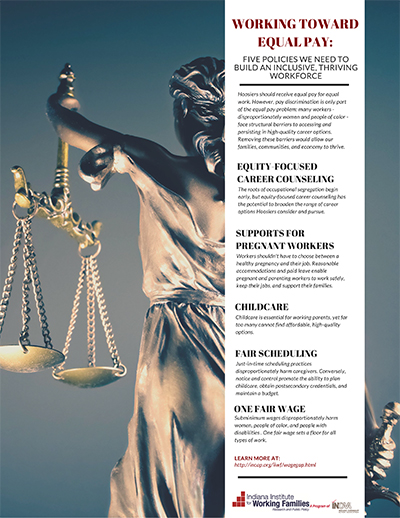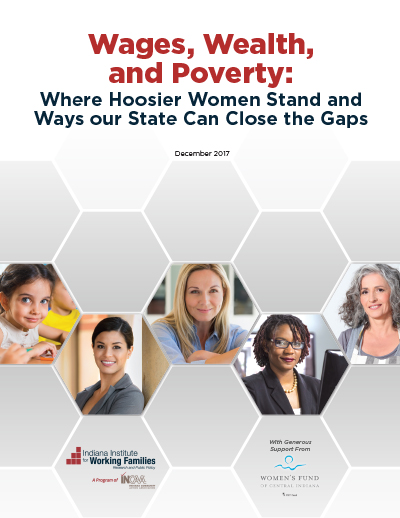Wage & Wealth Gaps
All Hoosiers should have the opportunity to support their families with jobs that pay adequate wages and allow them to balance work & family. However, unless our policymakers and community & business leaders work to combat bias, establish basic labor standards, and shore up work supports, we will continue to see unequal outcomes that keep Hoosiers from achieving their full potential.
Inclusive, Thriving Workforce Series
 Hoosiers should receive equal pay for equal work. However, pay discrimination is only part of the equal pay problem: many workers - disproportionately women and people of color - face structural barriers to accessing and persisting in high-quality career options. Removing these barriers would allow our families, communities, and economy to thrive. Hoosiers should receive equal pay for equal work. However, pay discrimination is only part of the equal pay problem: many workers - disproportionately women and people of color - face structural barriers to accessing and persisting in high-quality career options. Removing these barriers would allow our families, communities, and economy to thrive.
The following five key strategies are essential to promoting equal opportunity & equal pay:
Equity-Focused Career Counseling
Policy Brief | October 2019
Supports for Pregnant Workers
Policy Brief | October 2019
Affordable, Accessible Childcare
Policy Brief | October 2019
Fair Scheduling
Policy Brief | October 2019
One Fair Wage
Policy Brief | October 2019
 Wages, Wealth, and Poverty: Wages, Wealth, and Poverty:
Where Hoosier Women Stand & Ways Our State Can Close the Gaps
Indiana's gender wage gap grew two percentage points in 2016, making it one of the largest in the country. The median full time working woman earns nearly $13,000 less than the median full time working man. Meanwhile, women of color see even larger wage gaps. Differential income means differential ability to invest and secure access to credit, leading to even larger wealth gaps between men and women. Women are also more likely to experience poverty, especially single mothers.
With no single source driving the gender wage gap, Indiana will need to adopt multiple strategies to close it. These include:
- Providing tools like a stronger equal pay law and collective bargaining.
- Ensuring that teaching and counseling are equity-focused.
- Creating supports for work-family balance like pregnancy accommodations, paid leave, affordable childcare, and fair scheduling.
- Raising wages through increased minimum wage and access to education.
DECEMBER 2017 |Download the Report | Read the Executive Summary (below) | Contact the Author
Wages, Wealth, & Poverty Executive Summary
In Indiana, women earn less, own less, and experience poverty more often than men. These gaps raise important questions about identity, opportunity, and well-being, and they suggest that our systems could and should be structured differently to promote broader prosperity.
Wage gaps: In 2016 in Indiana, the median earnings of full time male workers were $12,717 higher than the median earnings of full time female workers. This is a 26 percent wage gap. Even as the nation’s wage gap narrowed between 2015 and 2016, Indiana’s wage gap widened 2 percentage points. The Hoosier gender wage gap is now the 6th highest in the nation, not far behind Louisiana and Utah, which, at 30 percent, are tied for the highest in the nation. Within Indiana, there is considerable variation from county to county, with some counties in Indiana showing nearly a 40 percent gap, while others have gaps in the teens.
Particular groups of Hoosier women experience even larger gaps. Black and biracial women experience a gap of 36 percent and the gap between Latinas and all Hoosier men who work full time is 44 percent – a difference of $21,567 per year. Median earnings for women with disabilities is $18,761 - $7428 less than the median earnings of men with disabilities and $21,269 less than men without disabilities. Acknowledging and addressing the distinctive and significant barriers to financial well-being that particular women face because of overlapping social identities is of critical importance.
Wealth gaps. While wage gaps in and of themselves result in significant differences in wealth over a lifetime, these gaps in wealth are compounded by the effect that depressed wages have on the ability of women to save, invest, and use credit. Nationally, there is a gap of 68 percent between the net worth of single men and single women. While a similar figure is not available at the state level, data suggest that Hoosier women disproportionately lack access to the building blocks of wealth. While more single women are buying homes, only 49 percent of female householders own homes as compared to 58 percent of male householders. And just 22 percent of businesses with paid employees are women-owned.
Research also suggests that women have less tucked away for retirement, they take longer to pay down debts like student loans, and are more likely to use higher-cost loan products. This leaves women more vulnerable to financial shocks and less able to retire with dignity.
Poverty gaps. Women are more likely to experience poverty than men. Statewide, 15.4 percent of women had incomes below the poverty line in 2016, while only 12.7 percent of men experienced poverty. Looking by family type, single mothers experience significantly higher poverty rates than married couples and single fathers: nearly 40 percent of single mothers had incomes below the poverty line in 2016. In some counties, more than half of single mothers experienced poverty.
Why do gaps persist? Both our country and our state have made progress in closing wage gaps over time, in part because we have taken significant steps to address the explicit and pervasive forms of workplace discrimination women once faced and because women today have more education and workplace experience relative to generations past. However, there are still significant hurdles to overcome. Men and women make choices about their careers, investments, and families in the context of different social expectations and constraints. Socialization that instills gender biases and limiting beliefs contributes to ongoing occupational and industry segregation, discrimination, and unequal divisions of labor within families. And with unequal access to workplace supports for caregiving and low wage floors, choices and opportunities to achieve financial well-being are limited in ways that not only put women at a disadvantage, but also harm Hoosier children and depress our economic progress.
Policy solutions. State policymakers can take a number of steps to address wage, wealth, and poverty gaps, including, but not limited to:
- Giving women the tools to address pay disparities through a stronger equal pay law and collective bargaining
- Ensuring that women and men know all their career pathway options, examine limiting beliefs based on gender, and make informed decisions through equity-focused professional development for K-12 teachers and improved career counseling.
- Facilitating work-life balance and supports for both men and women to engage in caregiving through paid family leave, childcare supports, paid sick and safe time, fair scheduling, and accommodations during pregnancy and nursing.
- Assuring access to family-sustaining wages by raising the minimum wage, removing barriers to postsecondary education, and increasing tax credits that support low-wage earners.
Related Resources
Fact Sheet: Pregnancy Accommodations in the Workplace
Nationwide, an estimated 250,000 pregnant women are denied small accommodations at work each year - like permission to sit down or carry a water bottle - and many more may be afraid to ask. This puts moms in the position of choosing between a healthy pregnancy and a paycheck.
NOVEMBER 2017
Clearing the Jobs Pathway: Removing Non-Academic Barriers to Adult Student Completion
In order to reach the state’s workforce and economic goals, Indiana needs leadership to better align resources for adult students and to remove barriers that stand between them and post-secondary education and training programs.
JUNE 2017
This publication outlines the case for paid family and medical leave, including the potential benefits of expanded access to paid leave for Hoosier families, businesses and the economy, describes what is currently available in Indiana and in other states & makes recommendations for state policy.
DECEMBER 2016
|


